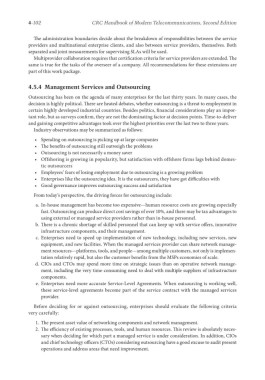Page 571 - Handbook of Modern Telecommunications
P. 571
4-102 CRC Handbook of Modern Telecommunications, Second Edition
The administration boundaries decide about the breakdown of responsibilities between the service
providers and multinational enterprise clients, and also between service providers, themselves. Both
separated and joint measurements for supervising SLAs will be used.
Multiprovider collaboration requires that certification criteria for service providers are extended. The
same is true for the tasks of the overseer of a company. All recommendations for these extensions are
part of this work package.
4.5.4 Management Services and Outsourcing
Outsourcing has been on the agenda of many enterprises for the last thirty years. In many cases, the
decision is highly political. There are heated debates, whether outsourcing is a threat to employment in
certain highly developed industrial countries. Besides politics, financial considerations play an impor-
tant role, but as surveys confirm, they are not the dominating factor at decision points. Time-to-deliver
and gaining competitive advantages took over the highest priorities over the last two to three years.
Industry observations may be summarized as follows:
• Spending on outsourcing is picking up at large companies
• The benefits of outsourcing still outweigh the problems
• Outsourcing is not necessarily a money saver
• Offshoring is growing in popularity, but satisfaction with offshore firms lags behind domes-
tic outsourcers
• Employees’ fears of losing employment due to outsourcing is a growing problem
• Enterprises like the outsourcing idea. It is the outsourcers, they have got difficulties with
• Good governance improves outsourcing success and satisfaction
From today’s perspective, the driving forces for outsourcing include:
a. In-house management has become too expensive—human resource costs are growing especially
fast. Outsourcing can produce direct cost savings of over 10%, and there may be tax advantages to
using external or managed service providers rather than in-house personnel.
b. There is a chronic shortage of skilled personnel that can keep up with service offers, innovative
infrastructure components, and their management.
c. Enterprises need to speed up implementation of new technology, including new services, new
equipment, and new facilities. When the managed services provider can share network manage-
ment resources—platforms, tools, and people—among multiple customers, not only is implemen-
tation relatively rapid, but also the customer benefits from the MSPs economies of scale.
d. CIOs and CTOs may spend more time on strategic issues than on operative network manage-
ment, including the very time-consuming need to deal with multiple suppliers of infrastructure
components.
e. Enterprises need more accurate Service-Level Agreements. When outsourcing is working well,
these service-level agreements become part of the service contract with the managed services
provider.
Before deciding for or against outsourcing, enterprises should evaluate the following criteria
very carefully:
1. The present asset value of networking components and network management.
2. The efficiency of existing processes, tools, and human resources. This review is absolutely neces-
sary when deciding for which part a managed service is under consideration. In addition, CIOs
and chief technology officers (CTOs) considering outsourcing have a good excuse to audit present
operations and address areas that need improvement.

